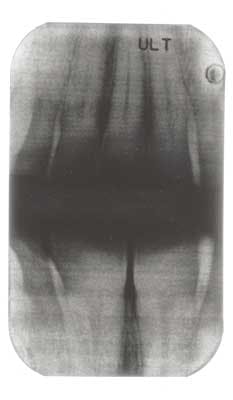Save time and money with these X-ray tips from Carestream Health: Ask the Expert for December 2010
Ask the Expert for December 2010 from Carestream Health
Christopher A. WarrenTechnical Support EngineerImaging ConsultantCarestream DentalExclusive manufacturer of KODAK Dental Systems
Last month we asked you to Diagnose the X-ray below and send in your answers on what you think the operator may have done wrong. Today we provide you with the image’s diagnosis!This month we seem to have everyone, as we received no correct responses! Be sure to send in your diagnosis for this month’s Diagnose the X-Ray for a chance to win.
X-ray AnswerActually, there are two separate issues with this image.Moisture contamination resulting in dark gray-black spotsMoisture contamination is most often caused by improperly storing film; this particular film was improperly stored in a refrigerator. When film is refrigerated, moisture or condensation can form on the film after it is removed from the cold storage. Moisture condensation will form on films and pre-develop tiny areas causing black spots. It is a somewhat common misconception to mistakenly believe refrigerating or freezing film will extend its shelf life. Refrigeration actually harms dental film as this example clearly shows. A yellowish or yellowish-brown colorThe yellowish color is typically the result of poor processing conditions. Most commonly the cause would be poor chemical quality or exhausted chemistry. Occurring after developer use, this problem is specific to poor fixing and can be easily avoided by properly maintaining and replenishing your chemistry.Tips and Tricks
- Never refrigerate or freeze film. Film should only be stored in conditions between 50 and 75 degrees Fahrenheit and 30% to 50% humidity. The film should easily perform as designed when stored under these proper conditions.
- Store film outside an operatory to reduce any secondary X-ray exposure and rotate film on a first-in first-out basis to ensure film does not expire
- To avoid processing problems, closely follow the processor manufacturer’s chemical changing and replenishment procedures. If using Kodak Dental Film, we strongly recommend also using Kodak Dental Chemistry. The two are designed to work optimally together to deliver the ideal density, contrast, and blue image tone. They also extend the film’s archiving quality.
- Never add water to top off or replenish any dental chemistry. Water will dilute already partially seasoned or exhausted chemistry, and actually make processing conditions worse.
- For automatic roller processors without auto replenishment, operator intervention is required to properly maintain chemistry. It is recommended that 8 oz. (236 mL) of replenisher be added to each working solution daily, based on an average daily run of 20 to 30 intraoral films. If more than 30, increase the amount of daily replenisher at the rate of 0.25 fluid oz. (7 mL) per additional film processed. (Even if no films are processed for a period of time, replenishment is necessary.)
- Replenished solutions should be changed every three to four weeks under normal conditions. (Normal is defined as 30 intraoral films per day). Manufacturers of automatic non-roller type processors recommend all non-replenished solutions be changed every two weeks.
What did the operator do wrong to achieve this image? CLICK HERE to answer.Be sure to look for the cause of the problem and Chris’s recommendation in our next issue!Contact usHave a question or concern about your KODAK dental film? If so, contact Chris.Looking for an authorized dealer?Need more information about KODAK dental film, call (800) 933-8031 or visit www.carestreamdental.com.© Carestream Health, Inc.The KODAK trademark and trade dress are used under license from Kodak.




